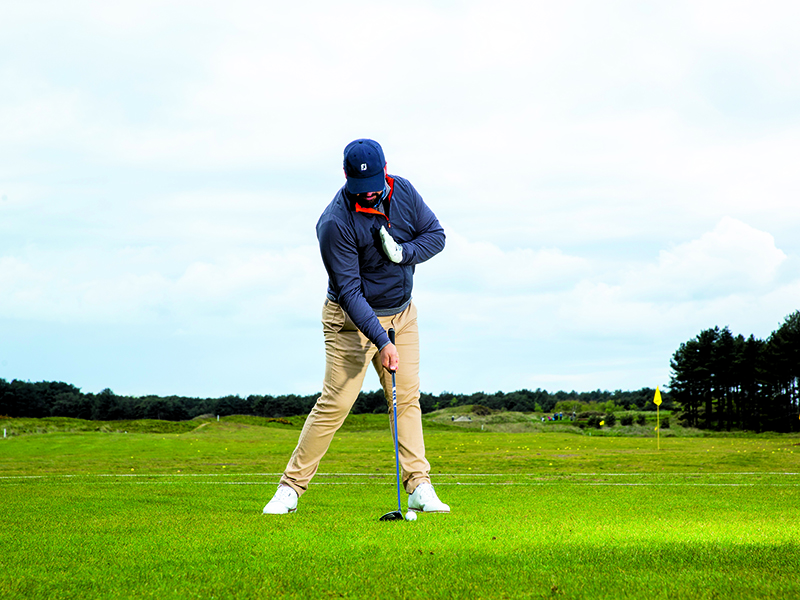Peter Finch Has The Formula For Flushing Fairway Woods... And He's Going To Teach You In 3 Simple Steps
Peter Finch is one of the most well-known coaches around, helping countless players to improve their ball-striking. Here, he shares three top fairway wood tips

Baz Plummer

You might own the best fairway wood on the market, but hitting the thing is a totally different matter and something many amateurs struggle with. Utilising these versatile clubs are an excellent way to bridge the gap between your driver and irons, providing support on those tough long par-5s and amplifying your ball striking options.
Either through a lack of confidence or a lack of understanding around how to correctly hit a fairway wood, many amateurs opt to leave them in the bag (or the car) and plod around without ever realising their full potential.
Fortunately for those golfers, we have a solution. Peter Finch is one of the most recognisable golf coaches on the planet, so we asked him to help us with this conundrum. In the video and article below, Peter Finch shares three top tips to help you flush your fairway woods...
Start Flushing Your Fairway Woods With 3 Super Simple Tips

Peter Finch is one of the most recognisable PGA professionals in the world, delivering online free lessons to golfers across the globe with a combined social following of almost one million people.
In his coaching career, Peter Finch has supported golfers of all abilities to play better golf and shoot lower scores.
1. Addressing Misconceptions
The biggest problem many people have is the thought process that, because it’s a wood, it has to be helped up in the air. But even though it has a low loft, it’s still enough to get the ball up, even if you hit it with a slightly descending strike.
If you’re topping your fairway woods it’s most likely that, as you’re coming through impact, your body is backing up and away from the target with the clubhead overtaking the hands. This means the club is ascending through impact and that’s why you’re catching the top of the ball and not hitting it flush.

This misconception could be costing you distance and shots on the golf course
2. Imagine The Circle
Subscribe to the Golf Monthly newsletter to stay up to date with all the latest tour news, equipment news, reviews, head-to-heads and buyer’s guides from our team of experienced experts.
To remedy this, think of an imaginary circle that the club takes around the body. It’s not a circle as it moves into different shapes but, for our purposes here, picture a circle.
The bottom of the circle is right in line with your sternum. As you move through the ball, keep your sternum over the ball. If your sternum stays on top of the ball, you cannot move back and away from it.

The bottom of the circle (low point) should align with your sternum for a clean strike
3. Control The Low Point
As you move through impact you want a fairway wood to be hitting the ball then just bruising the turf – just a little caress as it goes through. You don’t want a big, deep divot even though you can still hit successful shots like that.
To achieve this, your need to control the low point. Set up to a tee-peg just inside your left heel and take half a swing back. As you move through, you want the feeling of just clipping that tee. It’s only a little bit out of the ground so you just want to clip it.

Controlling the low point is crucially to achieve a consistent strike with fairway woods
Should I Opt For Fairway Woods and Hybrids Over Irons? Here's What The Kick Point Team Think...
A post shared by Golf Monthly (@golfmonthly)
A photo posted by on
Is A Fairway Wood And A 3-Wood The Same Thing?
GM says:
The simple answer is yes! There are many different types of fairway wood, and a 3-wood is one example. The loft on the club will differ depending on which fairway woods you use or have in your bag, and the level of forgiveness offered can also fluctuate.
Having the right woods in your bag can make a huge difference to your score, so invest some time finding the best fairway woods for you.

Delivering online free lessons to golfers across the globe with a combined social following of almost one million people, Peter is one of the most recognisable PGA professionals in the game.
Teaching philosophy:
I believe that golfers need to stop looking at other players and wishing they had 'that swing' and focus on trying to develop their own unique and trusted action. This comes from lessons based around enhancing their ability and understanding that perfection does not exist in golf.
Advice for practice:
Don’t just go to a driving range and beat balls thinking you will improve. If you simply use the amount of balls hit and time spent as a measure of practice, you won’t progress as quickly as you might like. True improvement comes from making your practice as realistic to the golf course as possible - uneven lies, different targets, different flights. You will almost never, ever get a flat lie in golf and yet where do most people in the UK pour their practice time? A flat range mat with the same repeated technique.
Most common problem:
A lack of attention to the club face and aim. Golfers should dedicate a large amount of practice time to gripping the club correctly and aiming it in harmony with their body.
- Baz PlummerStaff Writer
You must confirm your public display name before commenting
Please logout and then login again, you will then be prompted to enter your display name.